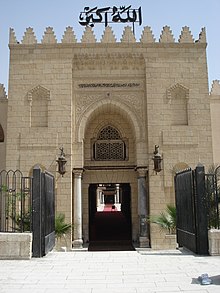| Amr ibn al-As Mosque | |
|---|---|
مَسْجِد عَمْرِو بْنِ الْعَاصِ | |
 | |
| Religion | |
| Affiliation | Sunni Islam |
| Location | |
| Location | Old Cairo, Cairo, Egypt |
| Architecture | |
| Type | mosque |
| Groundbreaking | 641 |
| Completed | 642 |
| Specifications | |
| Length | 120m |
| Width | 112m |
| Minaret(s) | 4 |
| Other name(s) |
|
The Amr ibn al-As Mosque (Arabic: مَسْجِد عَمْرِو بْنِ الْعَاصِ, romanized: Masjid ʿAmr ibn al-ʿĀṣ) is a mosque in Cairo, Egypt. Named after the Arab Muslim commander Amr ibn al-As, the mosque was originally built in 641–642 CE as the center of the newly founded capital of Egypt, Fustat. The original structure was the first mosque ever built in Egypt and one of the first in Africa.[1] For 600 years, the mosque was also an important center of Islamic learning until al-Muizz's Al-Azhar Mosque in Islamic Cairo replaced it.[2] Through the twentieth century, it was the fourth largest mosque in the Islamic world.[3]
The location for the mosque was the site of the tent of Amr ibn al-As. One corner of the mosque contains a room related in some significant way to his son, Abd Allah ibn Amr ibn al-As. Due to extensive reconstruction over the centuries nothing of the original building remains, but the rebuilt Mosque is a prominent landmark and can be seen in what today is known as Old Cairo. It is an active mosque with a devout congregation, and when prayers are not taking place, it is also open to visitors and tourists.[4] It is known by many titiles such as Taj al-Jawame' (Arabic: تاج الجوامِع, lit. 'Crown of Mosques').[2]

- ^ Behrens-Abouseif, Doris (1993). "Early Islamic Architecture in Cairo". Islamic Architecture in Cairo: An Introduction. The American University in Cairo Press. p. 47.
- ^ a b "Amr Ibn Al-As Mosque". sis.gov.eg. 20 July 2009. Archived from the original on 8 May 2019. Retrieved 16 May 2020.
- ^ Passant, Mohamed (12 April 2018). "Secrets of Amr ibn al-Aas Mosque, fourth in Islamic world". Daily News. Cairo, Egypt. Archived from the original on 23 January 2020. Retrieved 23 September 2018.
- ^ Eyewitness, p. 124